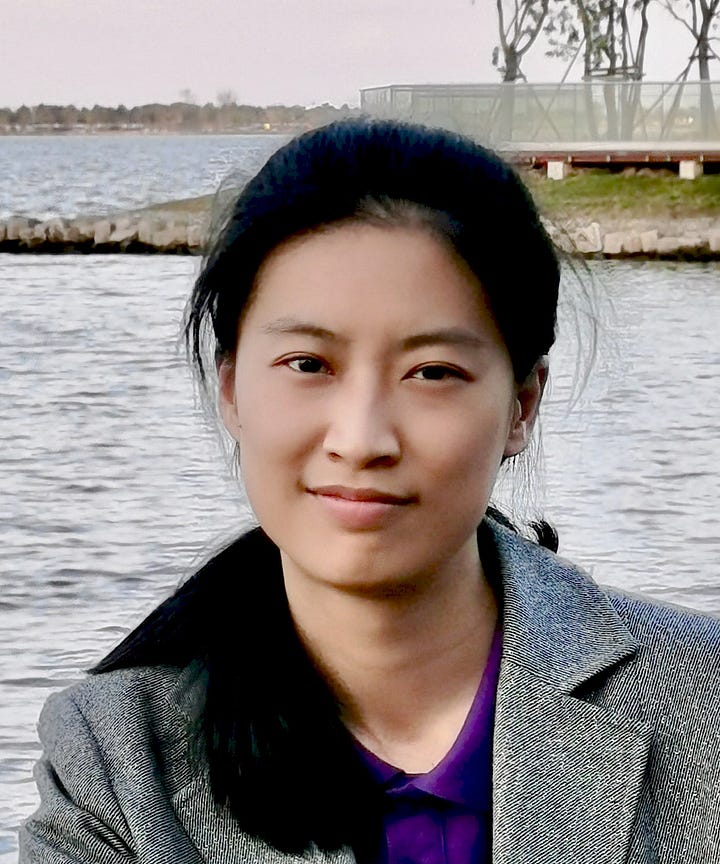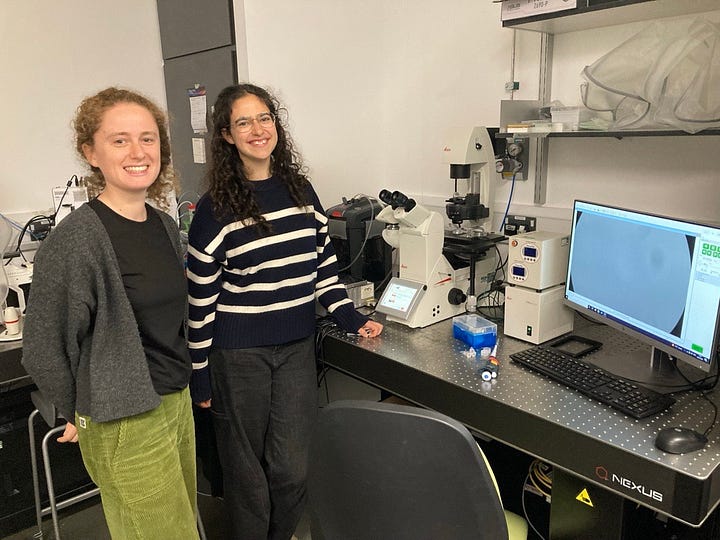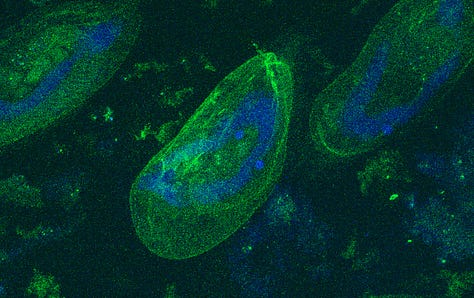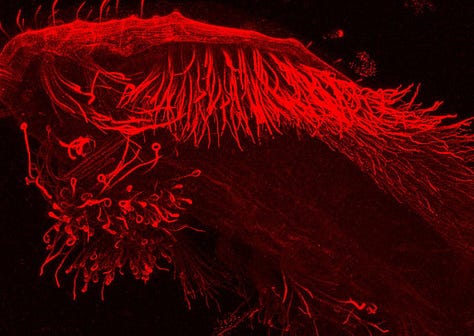Innovator Circles, FROs, and a look into biological computation
The latest from ARIA, including our new Innovator Circles initiative, inside Convergent Research's FRO-Founder Residency, and a Q&A with Nature Computes Better Creator Kirsty Wan.
What’s new at ARIA
News
We’re launching our new Innovator Circles initiative, to support individuals who want to convene their own informal, self-organised, technical peer groups to empower ambitious talent to conceive, debate, and pursue groundbreaking ideas. Learn more from ARIA’s Product Manager Pranay Shah below and apply by 23 October.
Matt Clifford has been reappointed as the Chair of ARIA to serve a second term. Hear more from him on LinkedIn and X.
The Encode: AI for Science Fellowship from our Activation Partner, Pillar VC, started this month, connecting top AI talent with leading science labs to catalyse translation. Dive into the projects.
The Big if True Science Accelerator (BiTS) programme from our Activation Partner Renaissance Philanthropy, also kicked off in September, designed to address a critical gap in the global research ecosystem by training scientists to build and launch R&D efforts that go beyond the scale of a single lab. Meet the first cohort.
Opportunities
Apply to be a Frontier Fellow with our Activation Partner Cambridge Neuroworks. The Fellowship is designed to empower people from all backgrounds, not just those already in neurotechnology, to thrive and shape the future of brain health. Hear from current Fellows and apply by 1 October.
Apply for our Activation Partner Nucleate UK’s 2025-26 Activator programme – the world’s largest open-access, equity-free biotech accelerator for early-stage founders, guiding founders through team formation, venture-building workshops, and expert mentorship. Find out more and apply – applications are reviewed on a rolling basis until late October.
Nucleate UK are hosting events across the UK for those considering an application. Discover them here.
Events
Join us in Cardiff as part of our roadshow, for an insight into how we find and fund ambitious people. Sign up to attend on 10 October.
Join us in Manchester for the launch of Venture Café Manchester as part of our Activation Partnership with CIC/Venture Café Global Institute. Sign up to attend on 23 October.
Come along to ‘Unlocking the Frontier: Understanding ARIA’ at Venture Café London’s Thursday Gathering, where you can engage with ARIA’s specialists in a hands-on session, discover upcoming funding opportunities, and gain a deeper understanding of our work and mission as we look to the next frontiers in science and technology. Sign up to attend on 30 October.
ARIA Innovator Circles: Betting on small groups to unlock big breakthroughs
Hear from Pranay Shah, who leads the Product Team’s Experimentation Unit at ARIA.
The most transformative ideas I’ve encountered didn’t start in formal presentations or polished papers. They began as random discussions in a research institute’s canteen over coffee, as impromptu ‘what if’ questions by bicycle racks, and as intellectual debates between friends who trusted each other enough to share half-baked thoughts.
This pattern isn’t coincidental. Throughout history, for both the sciences and the arts, breakthrough ideas have emerged from informal intellectual communities – spaces where people feel safe to be wrong, ambitious enough to think big, and connected enough to push each other toward harder problems. Yet looking around the research landscape in the UK today, there aren’t anywhere near enough of these high-trust, high-ambition spaces where nascent ideas are cultivated, debated and pursued.
That’s what drove us to run an experiment earlier this year to test the impact ARIA could have on ambition and culture. We supported five people from a range of disciplines and backgrounds with a small amount of funding and gave them a simple brief: create the kind of deeply technical community you wish existed. No prescriptive formats, no heavy reporting requirements – just the freedom to gather brilliant people around important problems.
Six months later, the results surprised us: groups had created new collaborations, pushed members to more ambitious work and discussions had already translated into real-world impact. One circle developed ideas that secured funding to build a new R&D organisation. Another created six new scientific software tools to accelerate discovery. A third sparked collaborations pursuing frontier synthetic biology research. Crucially, participants told us these groups gave them ’permission to pursue work they wouldn’t have attempted before.’
The experiment confirmed to us that a small amount of resources and encouragement can set off a chain reaction resulting in lasting impact: all the groups we supported indicated they were going to carry on beyond the end of our experiment. None of them existed before it. Our key learning was that the most ambitious researchers have ideas for the kinds of conversations they’d love to facilitate and the talent they’d like to convene, but they need someone to say “yes, this matters, go do it and build the group.”
Today, we’re saying exactly that. We’re launching ARIA Innovator Circles: an open call for anyone who wants to create these groups. Whether you’re a researcher with a vision for exploring under-appreciated problems, or a technologist who sees connections others miss, if you can imagine the scientific community you wish existed, we want to help you build it. To bring your group into existence, ARIA’s support will include covering materials costs (up to £2000/month), resources on how to build good groups, helping find venue space, and building connectivity between groups.
The format is entirely up to you: reading groups, a dinner series, research showcases, or something we haven’t thought of yet. What matters is creating environments where people can share early-stage thinking, challenge each other’s assumptions, and conceive ideas for the kind of transformative work that feels too risky to attempt alone.
Because here’s what I’ve learned: breakthroughs don’t emerge from individual genius. They emerge from peer groups that make genius feel possible.
Read more about our pilot experiment and lessons learned.
Find out more about how to apply for funding – applications close October 23rd.
Activation Partners: Inside Convergent Research’s FRO-Founder Residency
For the full potential of breakthrough science to be realised, it needs multiple pathways to the real world. That’s where our Activation Partners play a vital role — helping to create the conditions for bold ideas to thrive, building and connecting communities, and empowering those driving impact beyond the lab.
One of those partners is Convergent Research, the pioneers of the Focused Research Organisation (FRO) model: non-profit organisations tackling well-defined and high-risk scientific challenges to unblock a whole domain of technical progress in everything from neurotech to AI-for-maths. FROs fill in a missing institutional type – they’re tightly scoped, time-bound, engineering-heavy projects designed to produce public-goods that don’t naturally come out of existing institutions in academia, industry, or VC startups.
After four years building and launching nine FROs, Convergent applied to our Activation Partners programme with a new idea: move further up the pipeline and train scientific founders to launch FROs in the UK. As an Activation Partner, they created and launched the first-ever six-month FRO-Founder Residency with the aim to identify potential FRO founders then provide them with structured programming and coaching from Convergent’s highly experienced team. The ambition: to help exceptional scientists build FROs that can move at startup speed while maintaining scientific rigour.
“Moving from ad-hoc founder development to a structured, cohort-based bootcamp allows us to develop some really great resources, including weekly programming, roadmapping workshops, and a final symposium to sharpen proposals and align funders and early adopters,” says Adam Marblestone, CEO and co-founder of Convergent Research. “We’re hoping that the fast pace and focus of the residency, and the ability to osmose skills from peers, helps folks in our cohort build founder ‘muscle memory’ around bias-to-action, rigorous experimentation, milestone-driven execution, early-adopter engagement, and defining credible impact-exits. These are the capabilities our most successful teams to date have all shared, and that we’ve wanted to grow programmatically in all our work.”
This residency is a joint experiment in how FROs can be incubated and ultimately bridge engineering-heavy capability gaps in ARIA’s opportunity spaces. “It’ll be a huge success if this residency creates a new model that both supports UK talent and complements the existing ecosystem,” says Pranay Shah, Product Manager at ARIA, who leads our Activation Partners initiative, working closely with the partners to build new and bespoke programmes. “As well as running this residency with Convergent, we’ll also be selecting 1-2 FROs to fund in the hope they’ll grow the respective opportunity spaces and catalyse breakthroughs that wouldn’t otherwise happen.”
The selected teams are comprised of ex-start-up founders, leaders at major research institutes, leaders and co-founders of independent research organisations, faculty, and scientists from academia and industry. As part of the inaugural Convergent UK FRO-founder residency, they are:
Creating high-throughput platforms to understand brain connectivity in disease
Developing AI-powered software to democratise access to Earth-scale environmental data
Engineering heat-resistant symbiotic algae to save coral reefs
Building verifiable hardware-enabled government systems to ensure AI safety
Integrating ground-truth data collection with Earth observation to revolutionise ecological monitoring and forecasting
If you’re curious about FROs, join the Convergent UK Launch Party on 9 October at Venture Café London where you’ll get to hear from and meet Convergent, ARIA and some of the resident teams. And if this sounds like something you’d like to work on, Convergent is hiring – check out their open roles in the UK: Operations Manager and Operations Contractor.
Natural computation in single-celled microorganisms: A Q&A with Kirsty Wan (University of Exeter)
As a Nature Computes Better opportunity seed Creator, Kirsty and her team are working to better understand single-celled microorganisms. We recently caught up with Kirsty to learn more about how her research is developing:


What are you currently working on?
My research project is devoted to understanding how complex behaviour and excitability emerge in single-celled microorganisms. What do I mean by these terms? Typically, these traits are associated with larger complex animals, for example how they make conscious choices about where to go, when to eat, when to sleep, or how to escape suddenly from unexpected predators. Yet, the tiny, microscopic critters we culture in our lab are also capable of highly sophisticated tasks - despite having no brain or neurons. Many species move and swim in response to their environment, apparently at will. The capacity to perform all these activities must therefore be entirely self-contained within the physical architecture of the cell itself.
Our goal is to understand these microscopic cellular mechanisms at a deep, mechanistic level - teasing apart the myriad subcellular structures that give rise to complex functionalities. Fascination aside, imagine the possibilities if we could harness this embodied form of natural intelligence to engineer smarter robotic bodies at the microscopic - or even macroscopic - scale?
Above: Video of a Tintinnid - a kind of single-celled organism - reacting to a physical stimulus. Credit: Hannah Laeverenz-Schlogelhofer and Kirsty Wan.
What inspired you to work on this particular project?
Watching microorganisms move under a microscope is one of life’s simplest pleasures… In the beginning I used to look at cells swimming in a drop of water through the lens of fluid physics, wondering about the forces and mechanics that drive their movements. Increasingly, I started to think more about the cell-centric perspective – how does the cell perceive and interact with the world? There is so much more going on that we don’t understand, beyond the proverbial ‘bag of water with molecules inside’.
What do you wish more people knew about your research area?
I think it’s a genuinely fascinating and growing research area that is experiencing something of a renaissance. Modern neuroscience research has given us many insights into the formation and storage of memories, and the circuitry that encodes language, thought, and controls behaviour. Yet, understanding biological cognition from the bottom up could teach us a lot about the deepest connection between the ‘mind’ and the ‘body’ and could inspire novel designs for synthetic computational architectures (where the mind is the body).
What early findings or signals are emerging from your research so far?
Well I can’t give away too much yet! As a teaser, one thing that we have discovered is the power of expansion microscopy. It’s a conceptually simple technique that is unreasonably effective – the basic idea is that if you want to produce a more detailed picture of something tiny, you can expand your sample before imaging it! It has helped reveal the true (and surprising) extent of the structural organisation that can exist within a single cell.



And finally, which book/film/tv show should people check out to understand your project or discipline more?
When I was a student, I was inspired by reading Dennis Bray’s book – ‘Wetware: A computer in every living cell’. Published a long time ago and well ahead of its time, the book foresaw the value of framing cognition and the cell as information processing systems. I remember feeling rather star-struck when he came to my poster once at a conference in Cambridge! The other piece of writing that amused me was reading translations of Antonie van Leeuwenhoek’s letters to the Royal Society, penned over 300 years ago. When speaking of ciliates and flagellates he wrote: “I discovered little paws on the foresaid oval animalcules… that was likewise furnished with little legs”.
Meet the rest of the Creators funded by Nature Computes Better opportunity seeds.
F-Spec Corner
ARIA’s inaugural cohort of Frontier Specialists (F-Specs) are a small, dedicated team with the mission to dramatically expand ARIA's technical surface area and sharpen the cutting edge of the science we’re funding.
Here are some of the pieces our F-Spec Edith Hall has been digging into this month:
On the Feasibility of Fingerprinting Collaborative Robot Network Traffic
“As someone excited about the race to put robots in our homes, factories, and streets, I’ve been asking a simple question: What happens when these physical agents have the security posture of a 2010 webcam? Are we building a future where a hacker can’t only steal your data, but act physically on it too? We’re treating complex robots as just another node on the network, a fundamental miscalculation, but the authors argue that a robot isn’t a simple machine – it’s a deeply integrated cyber-physical system, where an attack isn’t confined to one layer. A vulnerability in high-level perception software could be exploited to cause a low-level actuator to perform a dangerous, kinetic action. Yet, we lack a holistic security framework that treats the robot as a single, unified entity. This is precisely where the need for a true cyber-physical trust infrastructure becomes so critical: an intrinsic, verifiable property of the entire stack, from the firmware managing the motors to the AI planning the next move. Without it, we’re not just risking data breaches, we’re creating physically embodied liabilities.”
Silk-inspired in situ web spinning for situated robots
“Roboticists struggle with a core paradox: that we tackle complex, unstructured environments with even more complex, centralised computation. What if, instead of programming a robot to navigate complexity, we gave it the tools to physically subsume it? Could a robot literally pave its own way, sculpting its body and environment in real-time? This is the essence of the in situ spinning approach by Vihmar et al. It represents a fundamental shift from today’s model-based, centralised control to a rule-based, embodiment-centric paradigm. The robot’s central control only needs to provide a global strategy (for example, ‘move to X’). The messy, complex, fibre-by-fibre development is fully delegated to the physical interaction between the spinneret, aerodynamics, and the ad-hoc environment. This process redefines embodied intelligence as something that happens during the body’s development, not just in the operation of a prefabricated form. What’s truly surprising is the system’s dual capacity: it simplifies chaotic environments by spinning a single, navigable surface, yet also transforms simple supports into complex, functional structures like grippers. The robot creates what are essentially transient organs (for example, a temporary finger for manipulation, a temporary pathway for movement) which are sculpted on demand. This points toward a future of unique, compliant, task-specific transient robotic forms built for the moment, rather than the brittle, universal designs we’re pursuing today.”
CRESt – Copilot for Real-world Experimental Scientist
“Many modern science labs are bifurcated. On one side, you have powerful robotic platforms capable of high-throughput 24-7 experimentation; on the other, the brilliant researchers who know what questions to ask and deliver on excellence in the scientific method. Traditionally, the bridge between them has been custom code, a specialised skill that creates a bottleneck, effectively limiting the full potential of these automated systems to the scientists who can also programme. CRESt (Copilot for Real-world Experimental Scientist) is designed to dismantle this barrier by functioning as a laboratory’s central nervous system, one that communicates in natural language. It leverages the function-calling capabilities of Large Language Models (LLMs) to translate a researcher’s voice commands into direct, physical action. For example, querying public databases like the Materials Project, executing machine learning algorithms, or directing physical hardware like liquid handling robots and robotic arms to carry out the request. A core challenge the researchers address is the inherent unpredictability of LLMs, a significant risk when controlling expensive, real-world equipment. Their mitigation strategy is to separate creative planning from vetted execution. The LLM is given the freedom to devise recipes and experimental parameters, but the execution is handled by a fixed framework of preset scripts written by human experts. This ensures that while the AI can explore novel ideas, it cannot generate potentially flawed or dangerous code on the fly for critical physical tasks. Ultimately, CRESt is presented not as a replacement for human researchers, but as a force multiplier that democratises access to automation and amplifies human intellect in a paradigm of ‘AI suggests, humans select’.”


